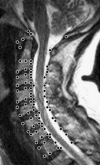The relationship between the cervical spinal canal diameter and the pathological changes in the cervical spine
- PMID: 19357877
- PMCID: PMC2899662
- DOI: 10.1007/s00586-009-0968-y
The relationship between the cervical spinal canal diameter and the pathological changes in the cervical spine
Abstract
A congenitally narrow cervical spinal canal has been established as an important risk factor for the development of cervical spondylotic myelopathy. However, few reports have described the mechanism underlying this risk. In this study, we investigate the relationship between cervical spinal canal narrowing and pathological changes in the cervical spine using positional magnetic resonance imaging (MRI). Two hundred and ninety-five symptomatic patients underwent cervical MRI in the weight-bearing position with dynamic motion (flexion, neutral, and extension) of the cervical spine. The sagittal cervical spinal canal diameter and cervical segmental angular motion were measured and calculated. Each segment was assessed for the extent of intervertebral disc degeneration and cervical cord compression. Based on the sagittal canal diameter, the subjects were classified into three groups: A, subjects with a congenitally narrow canal, diameter of less than 13 mm; B, subjects with a normal canal, diameter of 13-15 mm; C, subjects with a wide canal, diameter of more than 15 mm. When compared with Groups A and B, the disc degeneration grades at the C3-4, C5-6, and C6-7 segments and the cervical cord compression scores at the C3-4 and C5-6 segments showed significant differences. Additionally, when compare with Groups A and C, the disc degeneration grades at all segments, except C2-3, and the cervical cord compression scores at all segments, except C2-3, showed significant differences. With respect to the cervical kinematics, few differences in the kinematics were observed between Groups B and C, however, the kinematics in Group A was different with other two groups. In Group A, the segmental mobility at the C4-5 and C6-7 segments were significantly higher than those observed in Group B, and the segmental mobility at the C3-4 segment was significantly lower than that observed in Groups B or C. We demonstrated the unique pathological and kinematic traits of cervical spine that exist in a congenitally narrow canal. We hypothesize that kinematic trait associated with a congenitally narrow canal may greatly contribute to pathological changes in the cervical spine. Our results suggest that cervical spinal canal diameter of less than 13 mm may be associated with an increased risk for development of pathological changes in cervical intervertebral discs. Subsequently, the presence of a congenitally narrow canal can expose individuals to a greater risk of developing cervical spinal stenosis.
Figures
References
-
- Anderson PA, Steinmetz MP, Eck JC (2006) Head and neck injuries in athletes. In: Spivak JM, Connolly PJ (eds) Orthopaedic Knowledge Update, Spine 3. AAOS 28:259–269
MeSH terms
LinkOut - more resources
Full Text Sources
Medical
Research Materials
Miscellaneous


